Want to know how to make orgone on your own, but are unsure of what it involves? Don’t worry, I’ll walk you through the process!
(This post contains affiliate links, which means that if you choose to make any purchases through one of the provided links, aelestridcrafts.com may get a small portion of this sale. This does not cost you anything extra and helps to support site costs.)
Years ago I stumbled onto the concept of orgone (also known as orgonite) and found myself sinking hours into videos and how-to guides. My first thought was that the process seemed unwieldy in terms of price, materials, time, and knowledge requirements. Make orgone myself? Was that something I could try? When I found a group of pagan crafters like myself, I suggested a party where we could make orgone together. Everybody could pitch in for materials and share experiences, supplies, and support. So that is exactly what we did.
I won’t get into the particulars of what orgone is or what it is said to do here. The resin and metal shavings work together to amplify the energy of whatever else you put in. I thought that my pieces would resonate at whatever frequency I had made them for. The actuality exceeded all my expectations.
What I want to offer is a step by step guide of what to expect while creating orgone devices.
So this is what we’ll be making:
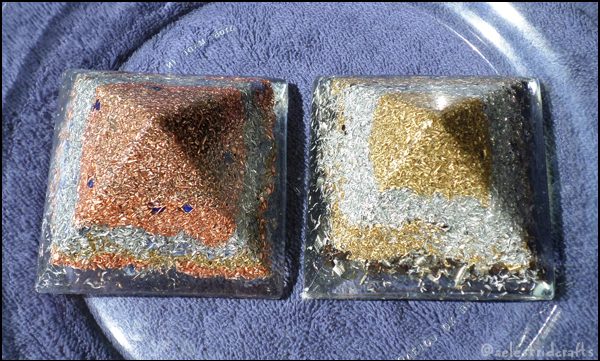
These pieces are referred to as Holy HandGrenades or HHGs. They are generally more decorative and personal than TowerBusters (TBs), which tend to be thrown into bushes or around towns to give their energy to the environment. HHGs can be made with particular intentions relevant to the person who will be using them. The above are two pieces out of a chakra set. Each piece has crystals that resonate and connect with the appropriate chakra.
So let’s get started!
What you need to make orgone devices:
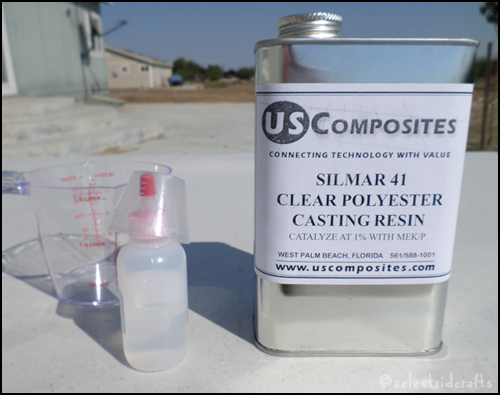
Resin with hardener. The above is clear casting resin that can be bought in the quart size (pictured) or larger. It is pretty pricey and it’s what you’ll be spending the most money on unless you choose to add something really special. You can get cheaper brown-tinted resin at any hardware store, but if you want your pieces to be visually appealing, clear casting resin is the way to go. Muffinpan Tower Busters that get thrown into bushes are fine to make with the cheaper resin, but a lot of people prefer to use nicer resin for HHGs.
As you can see, I bought Silmar 41 online at US Composites. It came highly recommended and also included a guide as to how much hardener to add, since this is not a 50/50 ratio resin. It’s the only resin I’ve used for this and I had good results with it.
It’s worth noting that having protection while using this resin is essential. Gloves, eye protection, and respirator masks are a good idea. This needs to be used outside or with adequate ventilation. Always check the safety sheet for the resin you are using and follow the instructions. This is not a substance you will want to breathe in or have contact with your skin, so be safe!
I use silicone mixing cups that I got from Amazon to measure my amounts of resin in precise increments. This is key to success for more complicated pieces and reduces waste. When I started years ago I bought cheap dollar store mixing cups but I hated throwing them away after each use, so I am happy to have silicone mixing cups that are reusable!
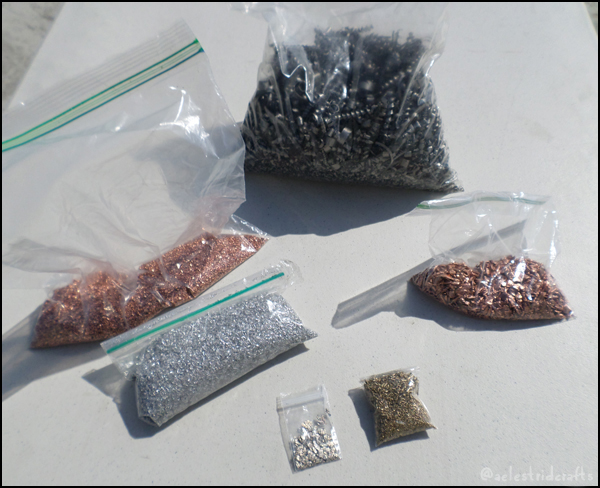
Here are your metal shavings. Any will do. Pictured above are copper granules, stainless steel, copper nuggets, aluminum, brass, and silver.
Some are cheaper than others, but what you go with should be a matter of preference. You can get these by asking around at metal shops and factories. I ordered all of mine online. Some of your metal shavings will come oily from the factory and the oil might cause an issue with the resin, so these will need to be washed in hot soapy water. I’m not going to say it was easy to wash and dry a ton of tiny metal coils, but I managed. I hear having a dehydrator helps. For me, it was lots of paper towels and air drying. Try to buy from sellers that list them as “oil free and clean” to save yourself the hassle, if you can.
I like to have a variety on hand because some pieces are more visually enhanced by silver metals, brass colored metals, darker metals, copper, etc. But to start with, you only need one type of metal, so pick what you prefer. They all work great.
How much metal do you need? It depends on your mold. For my 5 oz pyramid molds, I used maybe a teaspoon or two of each kind of metal I included. I had tons left over.
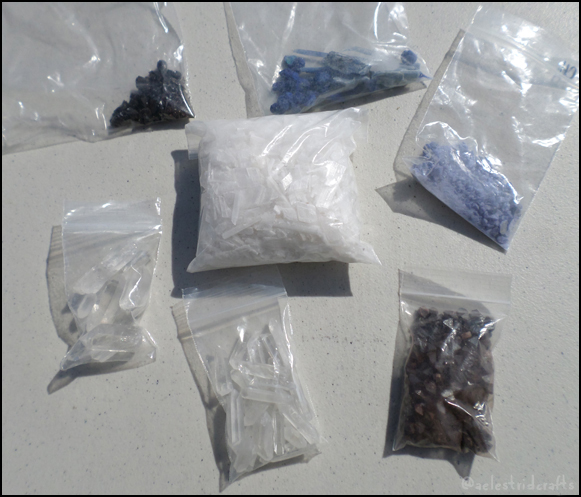
And here are your crystals.
Generally, to make orgonite all you will need is a quartz point, metal shavings, and resin. Don’t worry about having to add anything else; you don’t need to. However, if you want to, here are a couple things to keep in mind.
Gem shows and rock and mineral stores (NOT metaphysical stores) are good places to get chipped or rough crystals, crystals in bulk, or crystal sands/shards/dust which is perfect for orgonite. Check around and watch for good prices. Metaphysical places will try to charge a premium for these stones so buy from them only if something calls to you. Also, the crystals they sell will tend to be pretty and you won’t want to crack them up to put in orgone pieces where you might not even get to see them. Look for places that have boxes containing rocks from all over the world. They’ll have small pieces and a huge variety to choose from. I hit all the gem shows I can. You can order online if you’d like, but it’s always preferable to see and feel the crystals first.
Since orgonite is primarily an energetic endeavor, it helps if you are able to sense the energy from crystals. If you can’t, ask someone who can to help you or stick with just the quartz point. Some crystals don’t want to go in orgonite. Some won’t match the other crystals you plan on putting in. If, for instance, you get one of those mixed gem bags and just throw a handful in, you may find that the energy of your piece is trying to pull in too many different directions at once, like a bunch of voices all trying to talk over each other. Crystals, like people, need to be balanced with each other. Make sure the ones you are putting into a piece go together. Also, don’t feel like you need to put a ton in. Less is more if you know what you’re going for.
Some of the crystals above were not small enough to fit inside my mold, so I took a hammer and crushed them into small pieces. This may seem counter-intuitive but I felt that some pieces actually amplified their energy the smaller they were. This isn’t the case with all pieces and you’ll need to tune into the kind of energy intensity and radius you are trying to achieve when selecting sizes. Sometimes dust or sand will have frenetic or short radius energy spans while bigger chunks will have a more stable, longer range radius. Also, check with each stone you are considering breaking apart. Rocks by their very nature break apart into smaller pieces all the time but the stone you are considering may not want to be used in that way.
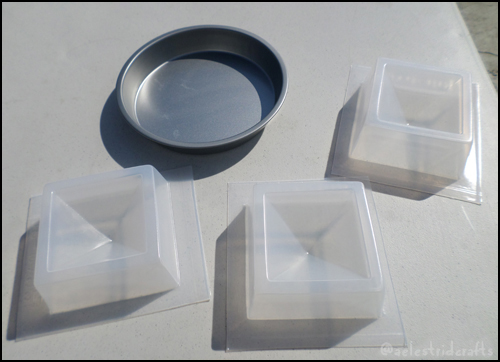
Now, you’ll need some molds. Your mold can be whatever you want it to be, in whatever shape, in whatever material, as long as it is heat resistant. Think baking friendly. When you make orgonite, the resin curing process releases a lot of heat which will melt cheap plastics (something we learned by experience) so go along the glass, metal, silicone route. One great thing to do is scour thrift stores for their cheap ornamental glass plates, delicacy glasses, martini glasses, and that kind of thing. If you’re looking for specific shapes, like a pyramid, you’ll find sellers online that make molds for orgonite purposes.
When I started this in 2014 there weren’t that many silicone molds out there to choose from, but now there are a *ton* and they are great. Ali Express, Wish, and sites like that have cheap silicone molds in incredible shapes. You can also make your own using a product like Smooth-On silicones (more on this later).
Alright, now that we got the basic supplies out of the way, here are a few other things to keep in mind. I mentioned the safety equipment, so be sure to have a safe adequate space to do this in (preferably outside) where pets and children won’t get into your curing pieces. This is a chemical process and until the pieces are fully cured you want as little contact as possible with the resin substance itself.
Some other things you might want to consider:
I always have stirring sticks for mixing (ideally these things will be silicone and reusable but it’s okay if you use disposable ones, so long as you are NOT USING ANYTHING YOU WILL BE COOKING OR EATING WITH LATER. What you use for resin projects can only be used for resin projects). You might also want mold release on hand if you fear you will need extra help getting your finished piece out of the mold, especially if you are using glass or metal.
You’ll also need a covered table to work on. Resin is super messy and no matter how careful you are it will spill and make a mess. You won’t be able to get it off surfaces easily so make sure you have a disposable table covering or you are doing it on a surface you don’t care about. Wear clothes you don’t care about getting messy either, or put on an apron. Have lots of gloves on hand because they get sticky if you are doing multi-layer pours or multiple pieces.
I use an oversized silicone mold from Amazon that completely covers my workspace and makes clean up amazing (once the resin is cured just pick it off and wipe the mat down). But you can use parchment paper or a table cover just as easily.
It helps to set up your components beforehand to make them easy to access. You can lay out your crystal grids in your workspace so that you’ll have it ready to place when you’re at the right stage.
Alright, we’re now ready to make orgonite! We’ll be doing some actual pouring in Part 2.
Aluminum should be excluded from your list. it’s energy field does produce a shield and it’s safe in small quantities, but in large amounts it transforms surrounding energy on to a horrible experience, and hurt the body in al levels. I did not read it. I have lived this after making more than 5 orgonites and also, even worse cases recently to orgonite producers in Latin America receiving level 8 energy attacks. Your article should mention this